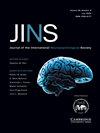Development and validation of a nonverbal consensus-based semantic memory paradigm in patients with epilepsy
IF 2.6
4区 心理学
Q2 CLINICAL NEUROLOGY
Journal of the International Neuropsychological Society
Pub Date : 2024-04-15
DOI:10.1017/s1355617724000158
引用次数: 0
Abstract
Objective: Brain areas implicated in semantic memory can be damaged in patients with epilepsy (PWE). However, it is challenging to delineate semantic processing deficits from acoustic, linguistic, and other verbal aspects in current neuropsychological assessments. We developed a new Visual-based Semantic Association Task (ViSAT) to evaluate nonverbal semantic processing in PWE. Method: The ViSAT was adapted from similar predecessors (Pyramids & Palm Trees test, PPT; Camels & Cactus Test, CCT) comprised of 100 unique trials using real-life color pictures that avoid demographic, cultural, and other potential confounds. We obtained performance data from 23 PWE participants and 24 control participants (Control), along with crowdsourced normative data from 54 Amazon Mechanical Turk (Mturk) workers. Results: ViSAT reached a consensus >90% in 91.3% of trials compared to 83.6% in PPT and 82.9% in CCT. A deep learning model demonstrated that visual features of the stimulus images (color, shape; i.e., non-semantic) did not influence top answer choices (在癫痫患者中开发和验证基于共识的非语言语义记忆范式
目的:癫痫患者(PWE)的语义记忆脑区可能受损。然而,在目前的神经心理学评估中,将语义处理缺陷与声音、语言和其他言语方面的缺陷区分开来是一项挑战。我们开发了一种新的基于视觉的语义关联任务(ViSAT)来评估 PWE 患者的非语言语义处理能力。方法:ViSAT 由类似的前人(金字塔和棕榈树测试,PPT;骆驼和仙人掌测试,CCT)改编而成,由 100 个独特的试验组成,使用真实生活中的彩色图片,避免了人口、文化和其他潜在的混淆因素。我们获得了 23 名公共工程参与者和 24 名对照参与者(对照组)的成绩数据,以及 54 名 Amazon Mechanical Turk (Mturk) 工作者的众包标准数据。结果:ViSAT 在 91.3% 的试验中达成了 90% 的共识,而 PPT 为 83.6%,CCT 为 82.9%。深度学习模型表明,刺激图像的视觉特征(颜色、形状;即非语义)不会影响最高答案选择(p = 0.577)。公共工程教育组的准确率低于对照组(p = 0.019)。一般来说,PWE 组的反应时间比对照组长,而且在语义处理(试答)阶段反应时间更长(均为 p < 0.001)。结论:这项研究表明,PWE 的表现障碍可能反映了非言语语义记忆回路的功能障碍,如发作起始区与关键语义区域(如前颞叶)重叠。ViSAT范式可避免混淆因素,具有可重复性/纵向性,可捕捉行为数据,并且是开源的,因此我们建议将其作为非语言语义记忆临床和研究评估的有力替代方案。
本文章由计算机程序翻译,如有差异,请以英文原文为准。
求助全文
约1分钟内获得全文
求助全文
来源期刊
CiteScore
5.40
自引率
3.80%
发文量
185
审稿时长
4-8 weeks
期刊介绍:
The Journal of the International Neuropsychological Society is the official journal of the International Neuropsychological Society, an organization of over 4,500 international members from a variety of disciplines. The Journal of the International Neuropsychological Society welcomes original, creative, high quality research papers covering all areas of neuropsychology. The focus of articles may be primarily experimental, applied, or clinical. Contributions will broadly reflect the interest of all areas of neuropsychology, including but not limited to: development of cognitive processes, brain-behavior relationships, adult and pediatric neuropsychology, neurobehavioral syndromes (such as aphasia or apraxia), and the interfaces of neuropsychology with related areas such as behavioral neurology, neuropsychiatry, genetics, and cognitive neuroscience. Papers that utilize behavioral, neuroimaging, and electrophysiological measures are appropriate.
To assure maximum flexibility and to promote diverse mechanisms of scholarly communication, the following formats are available in addition to a Regular Research Article: Brief Communication is a shorter research article; Rapid Communication is intended for "fast breaking" new work that does not yet justify a full length article and is placed on a fast review track; Case Report is a theoretically important and unique case study; Critical Review and Short Review are thoughtful considerations of topics of importance to neuropsychology and include meta-analyses; Dialogue provides a forum for publishing two distinct positions on controversial issues in a point-counterpoint format; Special Issue and Special Section consist of several articles linked thematically; Letter to the Editor responds to recent articles published in the Journal of the International Neuropsychological Society; and Book Review, which is considered but is no longer solicited.

 求助内容:
求助内容: 应助结果提醒方式:
应助结果提醒方式:


